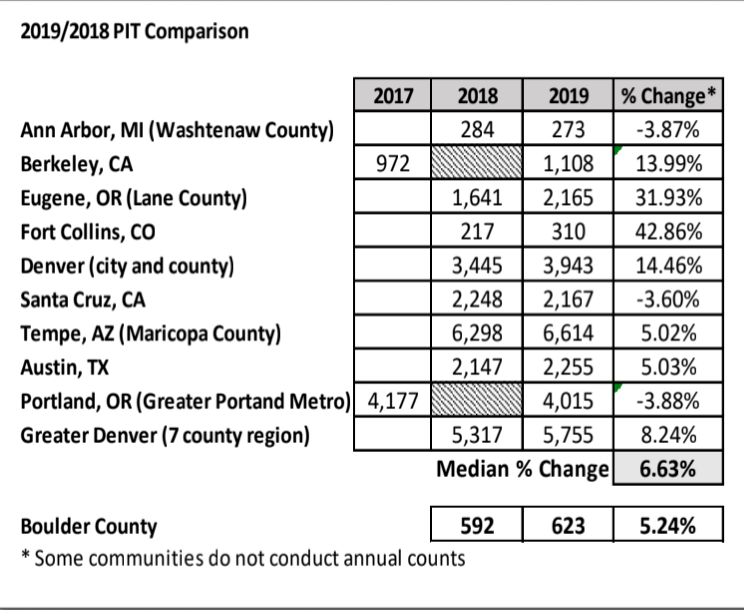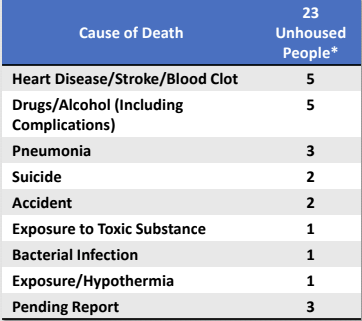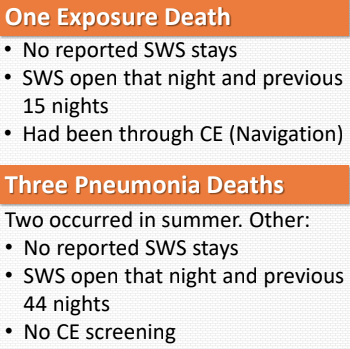Boulder delays vote on all-winter homeless sheltering as staff defends pending reduction in beds

Image via Shutterstock
Saturday, Jan. 11, 2020
Boulder’s elected officials this week bypassed a vote on all-winter sheltering for unhoused residents in favor of a larger discussion on the city’s approach to homelessness at the upcoming council retreat. At least three council members have said they’d like to see a change in how services are provided; staff has defended the county-wide housing first approach, including a pending reduction in the number of shelter beds, and this week presented data indicating that none of the record 48 homeless deaths in 2019 were due to lack of cold-weather sheltering.
It has been two years since Boulder County switched up how its approaches homelessness, pooling resources into a regional effort. All unhoused individuals seeking services must go through the coordinated entry system and be funneled into the appropriate programs and facilities:
- Diversion: If someone is unhoused and has been in Boulder County for less than six months, they will be given a bus or plane ticket, paid for with government funds, out of the county to be “reunified” with friends or family, someone with whom they can stay. Local reunifications are also classified as diversions, and some homeless individuals who have been in Boulder County longer than six months are also diverted.This approach has been criticized as not addressing the core issues of homelessness, instead shipping individuals out of the area to unknown circumstances. Officials argue that with limited funds, services should be focused on residents of Boulder County. Some critics also point out that there is no followup with those who have been “diverted” to know if they remain housed. Officials again counter that resources are limited and better spect on providing housing to local homeless.
- Navigation: Bridge House’s Path to Home provides these services, focused on individuals without disabilities who need a shorter period of stabilization. They are provided a case manager and then placed in treatment or programs, reunited with family or placed in “creative” market-rate housing.There are 50 navigation beds provided by Bridge House at 2691 30th Street, also the current location of severe weather sheltering.
- Housing-focused shelter: This is for individuals with a disability who have been homeless in Boulder County for longer than six months. They are placed in the Boulder Shelter for the Homeless to await placement in permanent supportive housing (housing + services).
Since its Oct. 2017 implementation, 3,341 unhoused people have gone through coordinated entry, according to city of Boulder staff. Of those:
- 366 have been housed (11%)
- 270 have been “reunited with friends, family or support systems” (8.1%)
- 118 have been referred to treatment or other long-term programs (3.5%)
People who have been unhoused in Boulder County for a long time have largely accessed housing already, Vicki Ebner, Homeless Initiatives Manager, said Tuesday night.
Officials spent much of the night asserting that the majority of homeless in Boulder are transient individuals just passing through. Staff-provided data seems to support this:
- 68% of those who accessed Path to Home navigation services in 2019 reported being in Boulder County for less than six months
- 42% of all those who have gone through coordinated entry report being in Boulder County for less than a month
- 48% of those who have used winter sheltering so far this season report being in Boulder County less than one month
For this reason and others, staff argued that navigation services be folded into Boulder Shelter for the Homeless when the 30th Street location closes this summer. The recommendation comes from Homeless Solutions for Boulder County, the group overseeing countywide efforts. HSBC is made up of providers, city and county staff, elected officials and at least one person with lived experience.
Fifty beds will be lost through consolidation. Staff admitted in its notes to council that this may result in there not being enough beds during part of the winter.
Though the new system could meet “average demand,” there is not yet “sufficient capacity for program consolidation,” the meeting packet read. “Further work to increase housing exits, particularly for people who are high utilizers of BSH beds, is needed.”
Placing such individuals into housing has already freed up significant shelter capacity, according to staff. Fifteen high utilizers who were able to use vouchers to attain permanent housing resulted in 14,354 collective available shelter nights, a 45% reduction in persons who remain at BSH for 300 or more nights.
Still, even without a 50-bed reduction, there were nights last winter when there simply weren’t enough beds for everyone. Currently, when severe weather sheltering is at capacity, navigation beds are used for overflow. When both those are full, people are transported across town to Boulder Shelter for the Homeless.
2018-2019 winter sheltering season
63 nights severe-weather sheltering over capacity
25 nights 30th Street (SWS + navigation) over capacity
3 nights total system (SWS + navigation + Boulder Shelter) over capacity
“It seems reasonably likely that by the time 30th Street closes, we won’t quite have the same amount of space,” councilman Aaron Brockett said. “What’s our plan?”
Kurt Firnhaber, director of housing and human services, said he believes enough people will be housed by next winter to free up more availability at Boulder Shelter: “I’m more optimistic than you are about what the capacity will be,” he said.
“I appreciate your optimism,” Brockett rejoined. “But let’s say it doesn’t go quite as well as you think. What’s our plan then?”
There isn’t one, Firnhaber said, beyond attempts to reduce demand by spreading the word that Boulder is full.
“We’ve been telling homeless folks who are from outside the community what our shelter capacity is,” he said. “Many people can go various places seeking services. It’s important and responsible of us to indicate to people what services we have and what services we don’t.”
“The approach of trying to provide to everyone” hasn’t worked in the past, Firnhaber continued. “Our shelter capacity has always been relative to the space we have.”
“I don’t think we’re trying to provide for everyone,” Brockett said. “But we’re losing capacity. We can’t quite fit demand into space. I need a plan.”
Brockett proposed keeping winter sheltering open every night of the season, October to May, a suggestion he made in 2019. But the conversation never advanced to a vote.
Council members Adam Swetlik and Rachel Friend indicated that they plan to make policy suggestions regarding homelessness a key part of their 2020 agendas
, to be considered at the upcoming retreat. Mayor pro tem Bob Yates suggested that the sheltering conversation continue as part of that discussion. A vote may be taken there or scheduled for later.
Councilwoman Mary Young indicated her unwillingness to expand sheltering, mounting the same defense she used last year to vote down the proposal: That doing so would draw more unhoused residents to Boulder, typing up resources that could otherwise be used to provide long-term housing.
“I want to make sure we’re not working against ourselves where we end up providing or giving people the choice that is less healthy for them,” she said.
Yates and councilwoman Mirabai Nagle joined Young last year in dissenting to Brockett’s suggestion. Mayor Sam Weaver was, at the time, open to all-winter shelters.
Staff shared some data from the Boulder County coroner on the 48 homeless deaths. No one died on a night shelters were over capacity, Firnhaber said.
Nineteen of the 48 were housed at the time of their deaths — the list always includes long-time or formerly homeless individuals, known to providers — and 23 were currently unhoused. Only one exposure death occurred, on a night shelter was available.
“What the data showed us is that people aren’t dying because they don’t have severe weather shelter,” Firnhaber said. “They’re dying because they’re camping in the streets.”
That makes it all the more important that we place as many people as possible into permanent housing, he said.
Firnhaber also restated the controversial claim that increased services draws more homeless people to the area. He used data from when shelters were run by Boulder Outreach for Homeless Overflow (more commonly known as BOHO). As capacity expanded, so did the number of those seeking them.

Homeless advocates have argued that correlation does not equal causation. The period was also marked by an increase in the numbers of unhoused across the county and steep increases in housing costs locally, one of the biggest drivers of homelessness.
Ebner herself on Tuesday noted that counts of unhoused residents have risen along with general population growth, though our per-capita homeless numbers have dropped. Boulder County’s point-in-time counts are in line with some of our neighbors and peer communities; in others, homelessness has increased exponentially.

Several community members spoke during open commentDedicated time at the beginning of regular council meetings, where up to 20 members of the public ca... to request that Boulder keep shelters open every night during the winter season and reevaluate its camping ban in light of recent legal challenges to the policy in other cities and states. Darren O’Connor, an attorney and frequent critic of the city’s approach to homelessness, delivered a petition with 300 signatures requesting all-winter sheltering.
“I hope the volume of emails (and signatures) is indicative of the community desire” for better services, O’Connor said.
Even if enough beds are technically available, Sarah-Jane Cohen noted, those with pets or children can’t access them, nor can those who have been barred due to behavioral issues. Such individuals have “no legal sleep options,” Cohen said — something referenced by the Denver judge who ruled that city’s camping ban was a form of cruel and unusual punishment, violating the Eighth AmendmentChange made to existing documents, resolutions, or ordinances to the U.S. Constitution.
Mark Gelband, another outspoken critic of the city on this and other policies, compared Boulder’s laws for people to those of animals. It is against city law to allow a dog, for instance, to remain outside without adequate shelter from the rain, snow or heat. The camping ban prevents unhoused people from exactly that: using shelter to protect from the elements while they sleep.
“It’s morally reprehensible for any of you to sit up there and allow one more person to die in the city of Boulder because they can’t use a sleeping bag (or) raincoat (or) tarp,” Gelband said. “You are complicit” in the deaths of unhoused residents.
Others argued that homeless deaths, which have galvanized concern and action, should not be the measure Boulder uses to analyze its policies.
“Looking at death is a really, really low bar,” said Madeline Goldstein. “Can we sink any lower? Even if people aren’t dying on the streets, somebody is paying for their healthcare if they’re out on the streets at night.”
Michele Rodriguez, a formerly unhoused resident, attended last month’s memorial service for many of her homeless friends. Another is currently in the hospital, she said, having his fingers amputated due to frostbite.
“He deserved shelter,” Rodriguez said. “He deserved shelter year-round. We’ve done a lot, but we haven’t done enough.”
BY THE NUMBERS: More on homelessness in Boulder County
Severe weather sheltering
Open 169 total nights in 2018-2019
Cost to operate in 2019: $170,000 (plus lease costs of $228,000)
846 people used SWS for at least one night
85% came through CE
Average age: 43
Average number of nights: 10 (median: 3.5)
Top 20 clients averaged 86 nights
Most use: 117 nights by one person
Path to Home navigation services
$750,000 cost to operate in 2019 (contract with Bridge House)
63% of city expenditure on adult homelessness
Family homelessness
Spending equaled $579,000 in 2019, including funding for Attention Homes, Emergency Family Assistance Association (EFAA), Mother House, and Safehouse Progressive Alliance for Nonviolence (SPAN)
Keep Families Housed launched in 2017: Pays for rent up to three times a year; payments #2 and #3 tied to certain requirements (getting kids to doctors, etc.)
In 2019 (through October) 364 families received rental assistance totaling $318,000 (580 distinct payments)
View a thread of Tuesday night’s council discussion here. View comments made by the public here.
— Shay Castle, boulderbeatnews@gmail.com, @shayshinecastle
Want more stories like this, delivered straight to your inbox? Click here to sign up for a weekly newsletter from Boulder Beat.
Homelessness Aaron Brockett Adam Swetlik Bob Yates BOHO Boulder Boulder County Boulder Outreach for Homeless Overflow Boulder Rights Watch Boulder Shelter for the Homeless Bridge House city council city of Boulder EFAA Emergency Family Assistance Association Homeless Solutions for Boulder County homelessness housing human services Keep Families Housed Kurt Firnhaber Mary Young Mirabai Nagle Path to Home Rachel Friend Safehouse Progressive Alliance for Nonviolence Sam Weaver severe weather shelter shelter beds SPAN unhoused winter sheltering




3 Comments Leave a comment ›